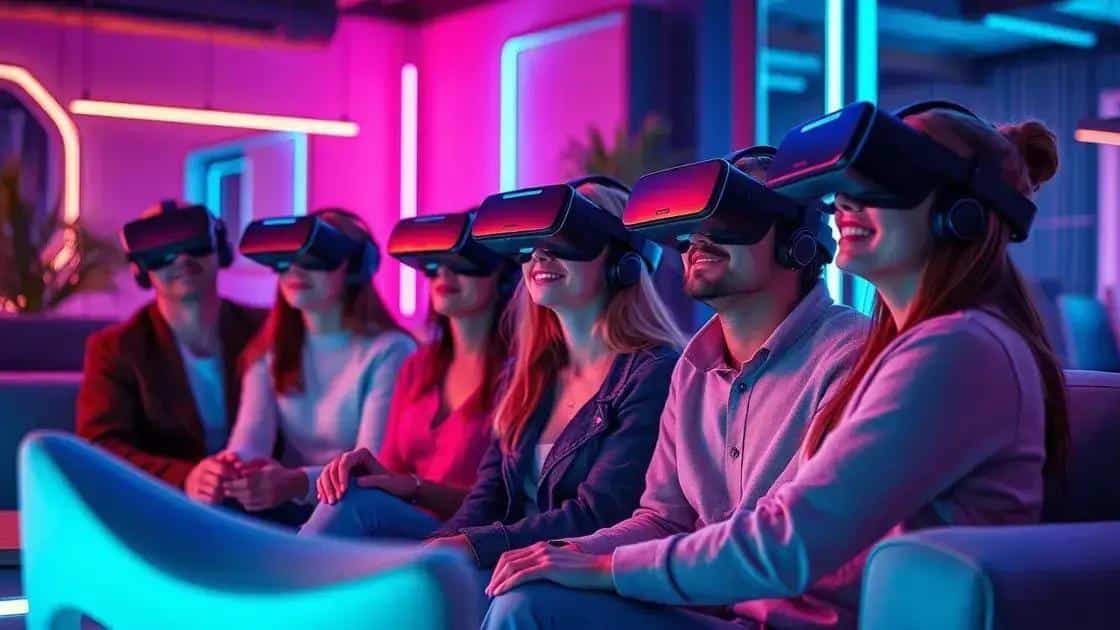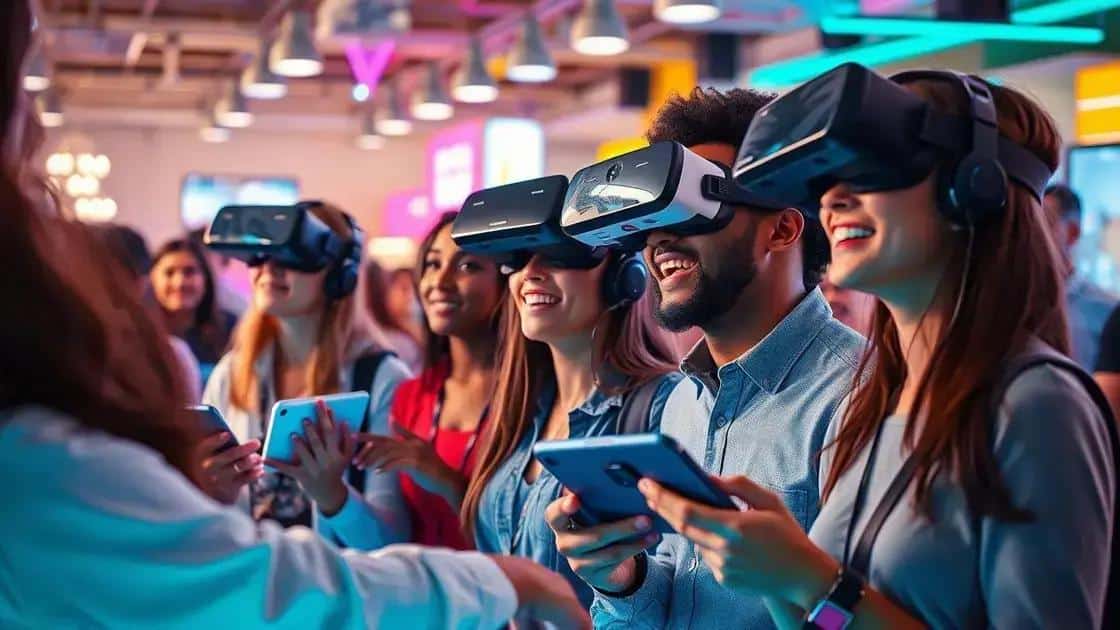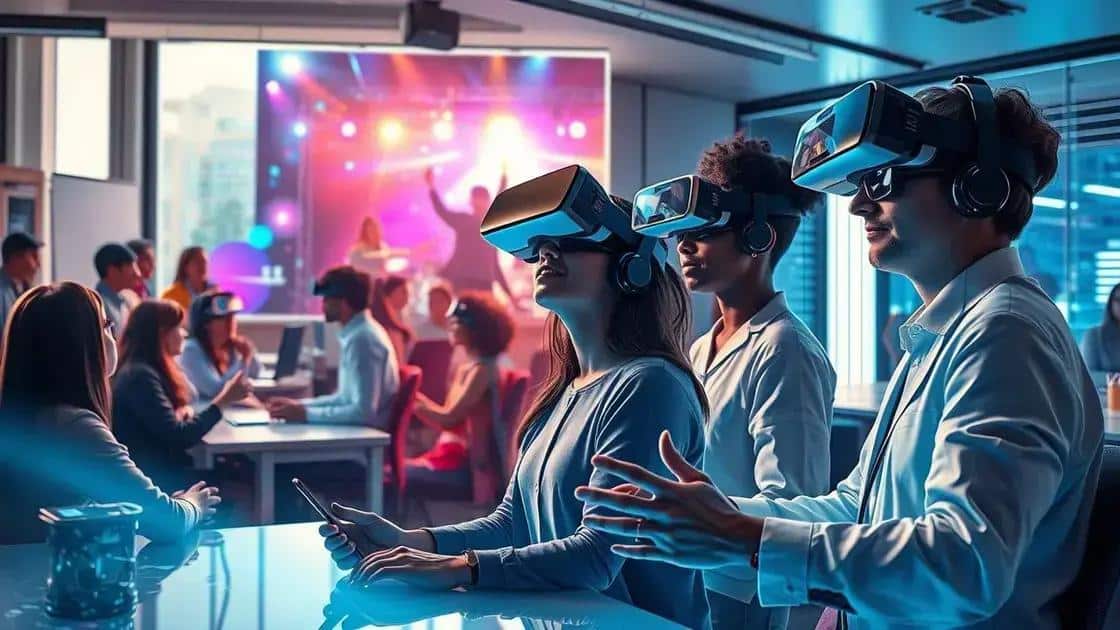VR/AR entertainment industry trends driving the future

The VR/AR entertainment industry is rapidly evolving, with trends indicating increased accessibility, enhanced social interactions, and personalized experiences driven by AI, shaping the future of gaming, media, and consumer engagement.
VR/AR entertainment industry trends are reshaping the way we engage with content, offering immersive experiences that captivate audiences. Have you ever wondered how these technologies are influencing our daily lives?
Emerging technologies in VR/AR
The emerging technologies in VR/AR are constantly evolving. This rapid change influences many sectors, particularly entertainment. Are you curious about what new advancements are being made?
Advancements in Hardware
Recent innovations in hardware have significantly improved user experiences in VR and AR. Devices are becoming more accessible and immersive, making them appealing to a broader audience.
- Lightweight headsets with better resolution
- Haptic feedback technology
- Motion tracking enhancements
- Wireless capabilities
An important aspect of these technologies is the integration of artificial intelligence. AI-driven software enhances the realism of VR and AR environments. For instance, AI can create more interactive and personalized experiences.
Software Innovations
On the software side, new applications are rapidly emerging. Developers are utilizing AR and VR for training, education, and social interaction. This expands the potential uses beyond traditional gaming and entertainment.
- Education and virtual classrooms
- Collaborative work environments
- Fitness programs using VR
- Art and design applications
These advancements are not just for individual experiences. Companies are using VR and AR technologies to create engaging marketing strategies. For example, virtual try-ons in fashion retail are growing in popularity, helping customers make informed choices.
As we explore the future, keep in mind how the landscape will change with the introduction of 5G technology. This new infrastructure will allow for faster data transmission, further improving the experience in VR/AR applications. The opportunities seem endless!
Changing consumer preferences

The changing consumer preferences in the VR/AR entertainment industry reflect how users interact with technology. As these technologies advance, audiences are becoming more discerning in what they enjoy.
Shifts in Demand
Consumers are no longer satisfied with basic experiences. They seek more immersive and interactive content. This shift means developers must innovate constantly to keep up with expectations.
- Increase in demand for social VR experiences
- Preference for personalized content
- Desire for cross-platform compatibility
- Interest in educational and informative AR applications
Alongside these shifts, audiences have shown a growing interest in the ability to customize their experiences. Users want to tailor settings, avatars, and content to suit their preferences. This trend drives innovation as companies strive to meet these desires.
Influence of Social Media
Social media plays a significant role in shaping consumer choices. Platforms showcase VR and AR experiences, making it easier for users to explore new options. As people share their experiences, it influences friends and followers.
- User-generated content boosts engagement
- Influencers promote innovative AR features
- Platforms enable direct interaction with content creators
- Trends spread quickly through viral sharing
Moreover, younger audiences are likely to adopt these technologies more quickly. They value experiences over products, making VR and AR a natural fit for their entertainment needs. As experiences become more popular, businesses must focus on creating unique offerings to attract this demographic.
Understanding these preferences is crucial for developers and marketers. This knowledge allows them to adapt strategies and create appealing content that resonates with modern consumers.
Impact on gaming and media
The impact on gaming and media from VR and AR technologies is profound, changing how users engage with content. Gamers are experiencing worlds like never before, thanks to enhanced immersion.
Transformative Gaming Experiences
VR technology allows players to step directly into their favorite games. With the use of headsets and motion controls, players can physically interact with the game environment. This level of immersion creates unforgettable experiences.
- Realistic simulations in sports games
- Heightened engagement in adventure games
- Social interactions in multiplayer environments
- Creative possibilities in sandbox games
On the other hand, AR integrates digital elements into the real world. This blurs the line between reality and gaming, providing players with unique experiences. Games like Pokémon GO have shown how AR can encourage outdoor exploration.
Influence on Media Consumption
The impact extends beyond gaming; media consumption is also evolving. Users are moving towards interactive and immersive storytelling. Traditional media formats are being replaced by content that allows viewer participation.
- VR films offering immersive narratives
- Interactive documentaries engaging users
- Live events streamed in virtual reality
- Gamified content enhancing audience participation
Moreover, brands are leveraging VR and AR to create advertising experiences that are memorable and engaging. Companies use these technologies to allow potential customers to try products in a virtual space.
As these changes continue, it’s clear that the gaming and media industries will keep evolving. The growth of VR and AR technologies promises even more remarkable advancements in how stories are told and played.
Future predictions for VR/AR

The future predictions for VR/AR technologies are exciting and full of possibilities. As advancements continue, we can expect significant changes in how we interact with virtual environments.
Increased Accessibility
One major prediction is that VR and AR will become more accessible to the general public. This includes lower prices for hardware and improved software that runs on everyday devices. As barriers drop, more people will engage with these technologies.
- Affordable headsets and accessories
- Smartphone compatibility for AR features
- Free or low-cost platforms for content
- More user-friendly interfaces
As these technologies become integrated into daily life, applications in education, healthcare, and business will flourish. For example, AR can enhance learning experiences in classrooms, making lessons more interactive and engaging.
Enhanced Social Interactions
Another prediction is the continued integration of social elements into VR and AR experiences. Virtual meeting spaces and events will create new avenues for connection among users. Imagine attending concerts or events from the comfort of your home, feeling as though you are truly part of the experience.
- Virtual reality classrooms and training sessions
- Social networking in AR environments
- Shared gaming experiences
- Collaborative workspaces in virtual rooms
Additionally, the fusion of AI with VR and AR technologies will personalize experiences. As users interact more with these platforms, AI will learn their preferences, offering tailored content that matches individual interests.
These advancements will also push creative boundaries. Developers will explore new storytelling methods, using immersive environments to tell complex narratives that engage audiences in interactive ways. As VR/AR technologies evolve, the potential for innovation seems limitless.
FAQ – Frequently Asked Questions about VR/AR Entertainment Technology
What are the main applications of VR and AR in entertainment?
VR and AR are used for immersive gaming experiences, interactive movies, and educational content that enhances learning.
How does AI integrate with VR and AR?
AI can personalize experiences by analyzing user data and preferences, enhancing the interactivity and relevance of virtual environments.
How can I ensure my VR or AR experience is accessible?
Designing with inclusivity in mind, using affordable devices, and ensuring compatibility with common platforms is key to accessibility.
What is the future of VR and AR technology?
The future includes enhanced social interactions, increased accessibility, and innovative applications across various industries, promising exciting developments.






